Back in 2019, while releasing the teaser of Mission Mangal, a film based on India’s Mars mission, Akshay Kumar, the male lead wrote on Twitter (now X):
‘Jitna uncha ho asmaan, yeh sindoor utni door tak jaayega!‘
When an image of the women scientists of ISRO went viral, social media went gaga over their saree, sindoor, kumkum and mangalsutra posting their photos with strange captions like: ‘They don’t need to wear jeans‘, ‘This is what real feminism looks like‘, ‘Modernism does not mean women embracing cigarettes and alcohol‘ et al.
The voice over in the teaser itself also incorporated words like kangan and mangalsutra (they even tried to create an alliterative rhythm while pronouncing mangalsutra and Mangalyaan under the same breath). The propensity of misplaced praise, therefore, has always been there in the sexist culture of ours. It emerges every time, especially, when we have women as achievers.
The saree-clad women of ISRO
Coming back to 2023, India burst out in jubilation as Chandrayaan-3’s lander module successfully touched the southern polar region of the moon, thereby asserting the country’s astronomical prowess. With this achievement, in fact, India became the first country to soft-land in the lunar south polar region. The hard work, dedication and resilience of the space community deserve to be duly applauded, irrespective of the gender of the individuals. However, on the contrary, when an image of the women scientists of ISRO went viral, social media went gaga over their saree, sindoor, kumkum and mangalsutra posting their photos with strange captions like: ‘They don’t need to wear jeans‘, ‘This is what real feminism looks like‘, ‘Modernism does not mean women embracing cigarettes and alcohol‘ et al. One verified user named swatic12 even wrote:
‘Sab important hai, moon bhi, ghar ki responsibilities bhi and no one better than Indian woman who can handle it all. Respect!’

Any and every occasion of an achievement by an individual woman, thus, has always been used as another opportunity to belittle women as a community. A woman boxer or woman wrestler, thus, often becomes the model of ‘real feminism’, while women en masse are reduced to a cult of uncultured, jeans wearing, smoking and drinking “pseudo-feminists”, who disobey age-old customs frivolously (It is a pity, however, that the so-called ‘real’ mascots of feminism too have to bear the brunt of police lathicharge when they ask simply for an extensive investigation against the pervert chairperson of the wrestling federation).
Such collective outbursts seem to care less about celebrating the achievements, and more about teaching women about the various lakshamrekhas. The underlying message is simple: Parampara, and not perseverance, is the key to success.
Reducing ISRO scientists to their attires
Keeping with this tradition, the iconic ‘women of ISRO’ became not the symbols of scientific calibre that could have inspired a generation of girls to take up STEM, but the vanguards of the misogynist Indian culture where a woman is to be judged first and foremost by her attire.
While the spotlight was being diverted from the women’s technological excellence to their appearances, however, the skill and knowledge of these supposed ‘role-models’ were being trivialised in comparison to their attires.
While the spotlight was being diverted from the women’s technological excellence to their appearances, however, the skill and knowledge of these supposed ‘role-models’ were being trivialised in comparison to their attires. The maestros, through this patriarchal process, became merely some sati-savitris decked up with saree-sindoor-mangalsutra, who by some miraculous power, derived from their purity and loyalty to traditional norms a la the mythological stories of Sati and Savitri have made the impossible mission possible.
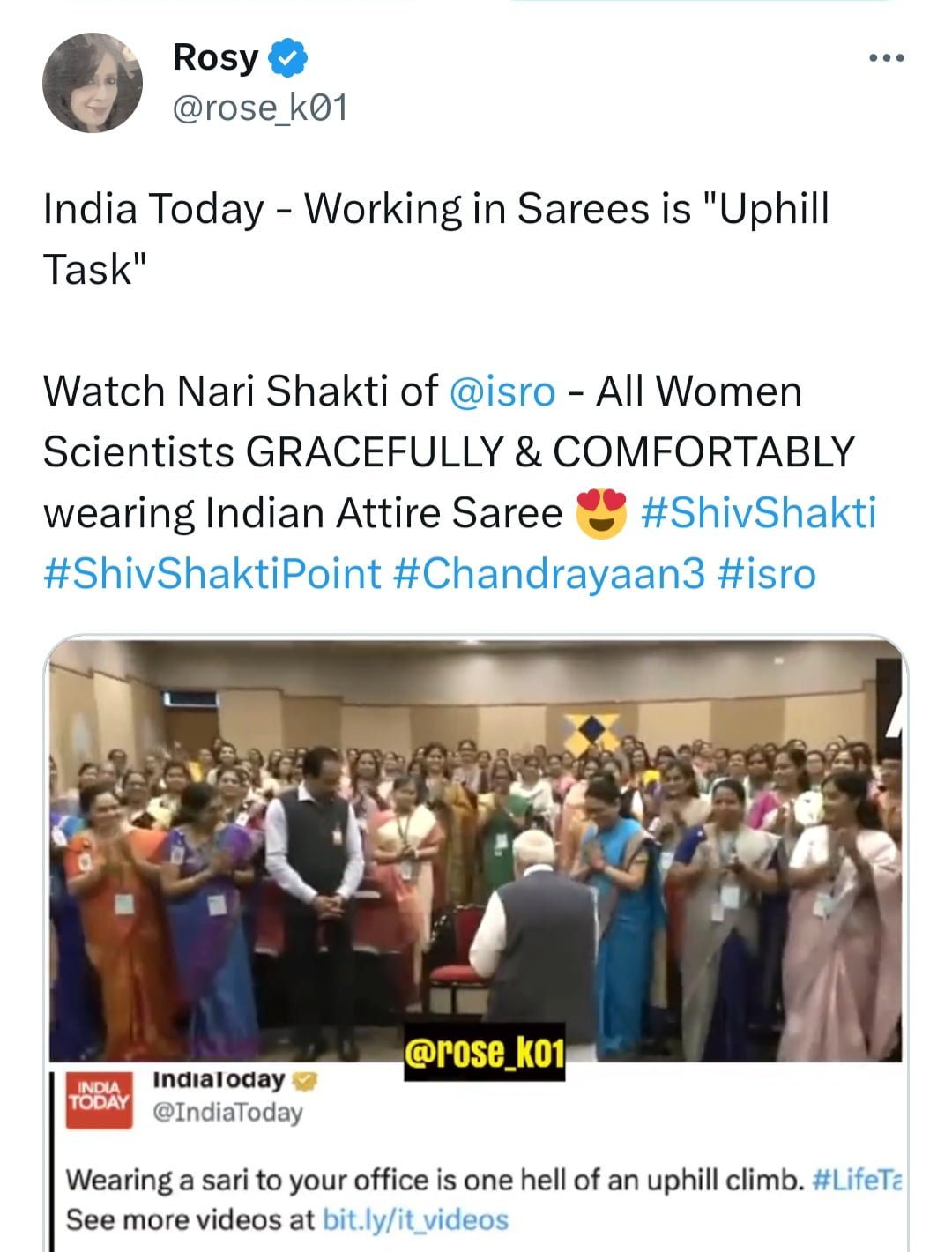
For that matter, attire, in its turn, also signifies something: in this case, the compliance to patriarchy. This may remind one that, Andrea Dworkin further extended Beauvoir’s thread of thought and opined:
‘Woman is not born: she is made. In the making, her humanity is destroyed. She becomes a symbol of this, a symbol of that: mother of the earth, slut of the universe; but she never becomes herself because it is forbidden for her to do so.’
The patriarchal myth of women as multitaskers
In the social media posts celebrating the saree clad ISRO scientists, the message, however, was that rocket science and roti can go hand in hand, implying that women are genetically destined to be multitaskers.
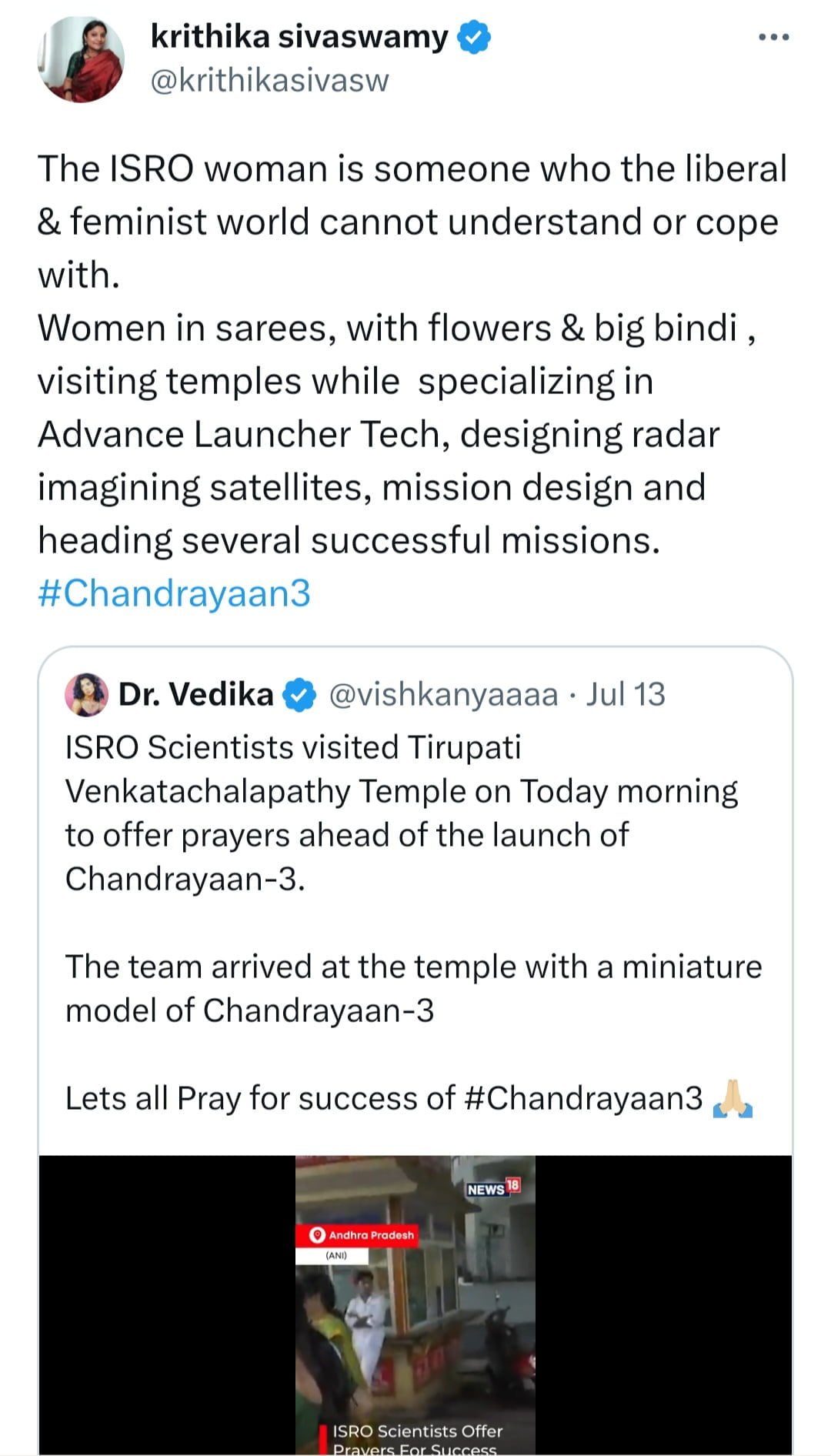
This perpetuates the patriarchal subjugation of women who remain overworked, under-acknowledged and simply exhausted.
In the first place, women do not need to be mansplained on “real womanhood’ or “real feminism”. They are supposed to know that feminism is hardly about attires and any other external embellishment . It is about the struggle for gender equality. When we see that instead of the male scientists (who were comfortably wearing western formals), the women scientists, are being scrutinised on the basis of what they wear, we feel the urgent need for feminist philosophy and activism.

It was all the more disturbing to view that even women at large, imbibing the patriarchal indoctrination, were upholding in the social media the same technique of woman bashing. They, too, inadvertently downplayed the expertise, education and training of the women scientists, by stressing on what they wore. just to shame the not-so-traditional “jeans-clad” counterparts of theirs.
It was all the more disturbing to view that even women at large, imbibing the patriarchal indoctrination, were upholding in the social media the same technique of woman bashing.
However, in a government workplace it is a common practice to wear formals. Irrespective of gender, nobody wears a pair of casual jeans in a government office, nor has a workplace ever been an ideal place for consuming alcohol. This, again, reminds usthat back in the eighteenth century, Mary Wollstonecraft was dubious about the acceptance of what she preached, even among the women themselves. She said:
‘My own sex, I hope, will excuse me, if I treat them like rational creatures, instead of flattering their fascinating graces, and viewing them as if they were in a state of perpetual childhood…’
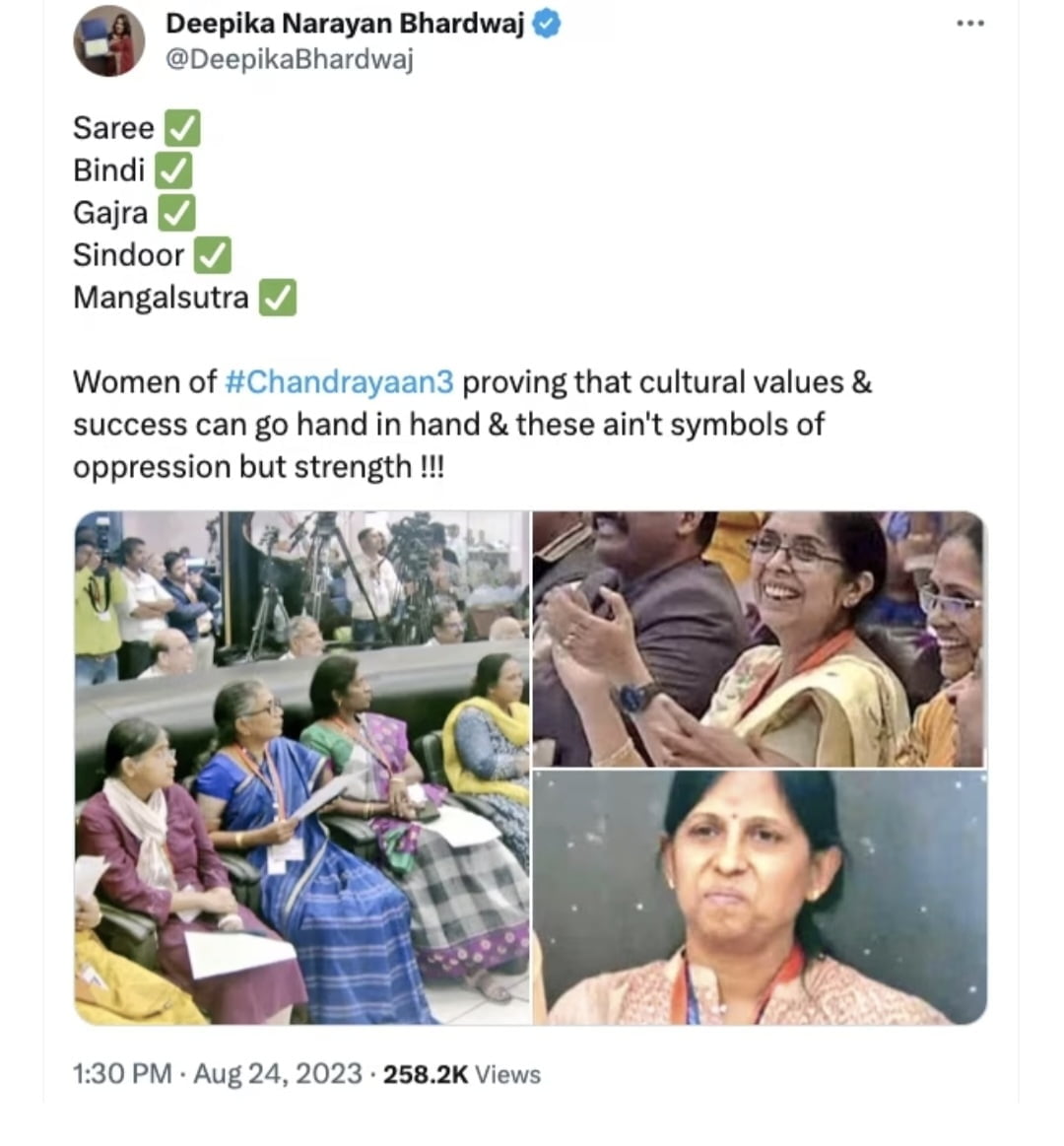
If such patriarchal, conservative outcries pervade, can the Right Wing Brigade be far behind? They basked in the glory of “Hindu tradition” of Sari and Sindur and Mangalsutras and stressed the factthat the ISRO women “looked so Hindu”.
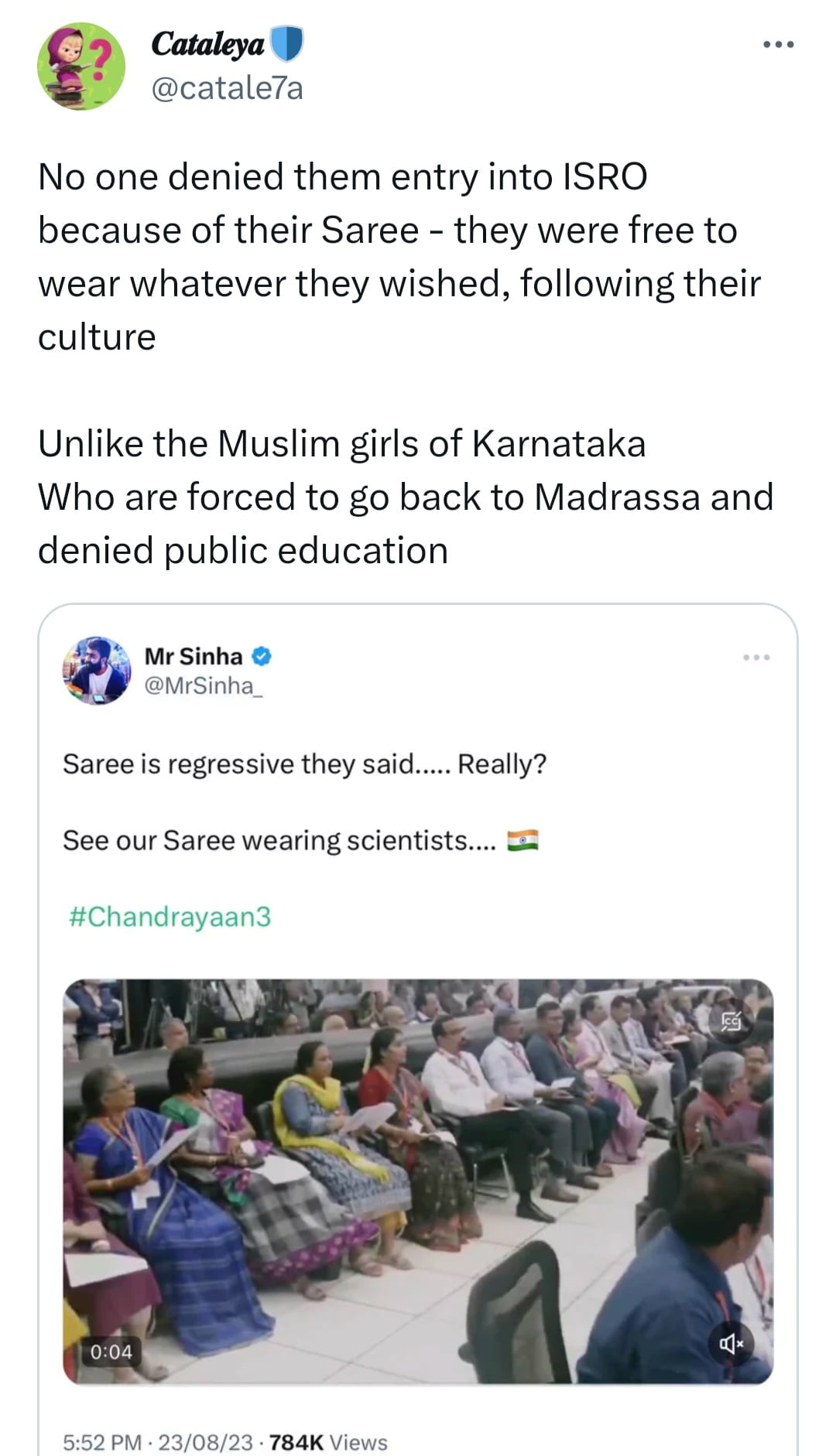
The struggle of women in STEM
The entire fiasco overshadows the state of women pursuing STEM against odds. Nevertheless, let us have a look at what statistics show. Women make up around 40% of undergraduates in science. But only 25-30% of science PhDs are women, according to a 2015 report by The Association of Academies and Societies of Sciences in Asia. Moreover, women in faculty positions only make up around 15% of the total. It is assumed that the preference for a “trouble-free” career could be one reason why even now only 14.3% of science researchers in India are women (as mentioned in a recent World Economic Forum report). But why do women need to have trouble-free careers? Isn’t it becausefm according to traditional norms, women and not men solely identify as a homemaker, responsible for rearing a child and a family? Isn’t it the very ‘mangalsutra/ sindoor-celebrating’ tradition that perceives marriage and not career as the primary goal of a woman?
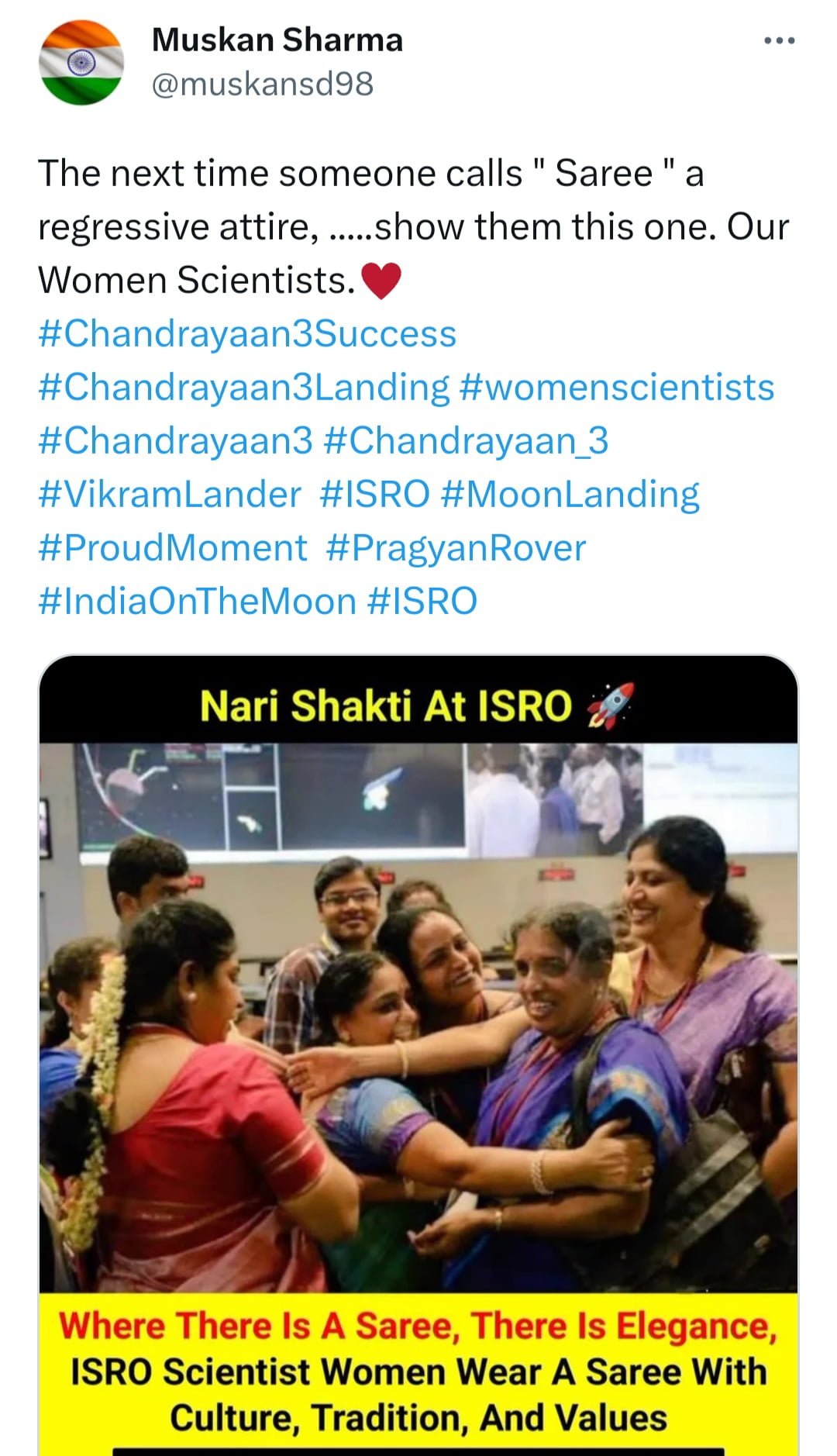
According to a 2010 report by the Indian Academy of Sciences and National Institute of Advanced Studies, 14.1% of women in science research were never married, as against only 2.5% of men. The same report also concluded that while 46.8% women worked 40-60 hours a week (in order to prove their mettle), 66.5% men worked for fewer hours.
The renowned Nobel laureate and biochemist Tim Hunt once infamously said that three things happen when women are in the lab: ‘You fall in love with them, they fall in love with you, and when you criticise them, they cry.‘ This statement only ascertains the fact that even science labs can be hubs of gross misogyny.
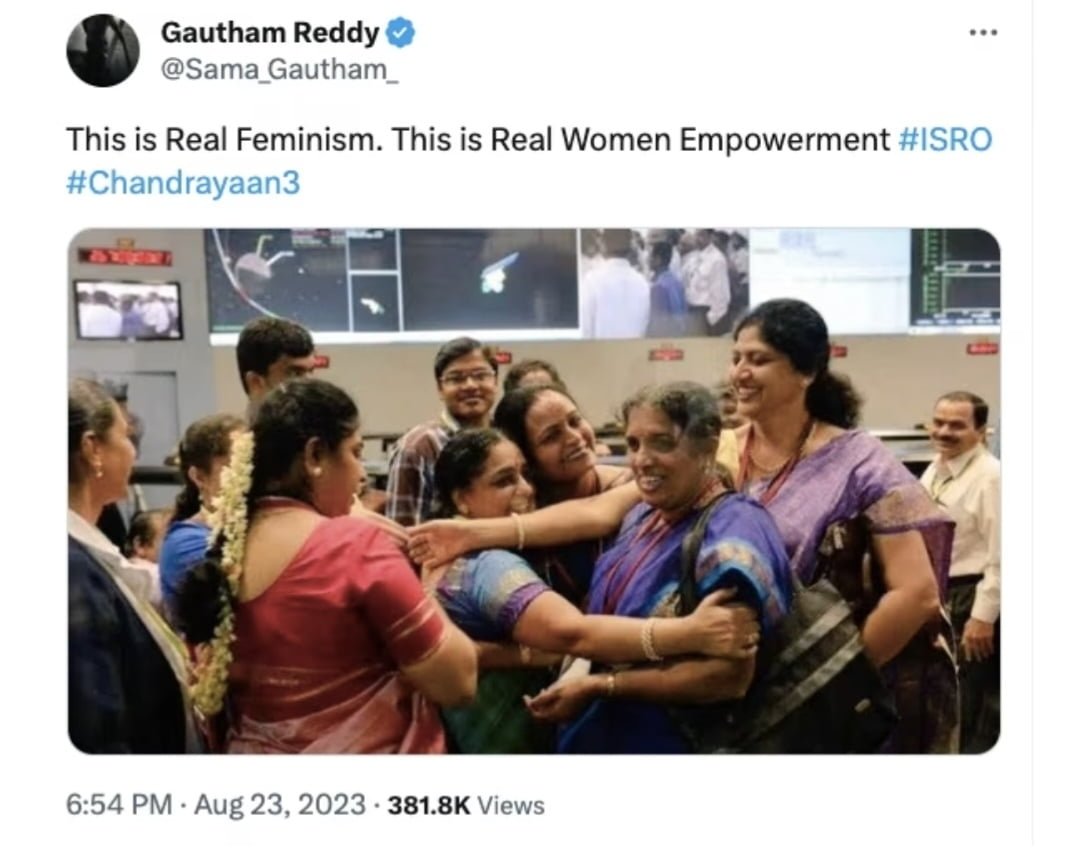
At this juncture in time, it is imperative to take a second look at the viral pictures of the saree-clad ISRO scientists and spare a minute to rethink: is it possible to be a scientist, a supposedly genderless pursuer of knowledge in its purest forms, and be a socially accepted, tradition-abiding “good woman” at the same time?
About the author(s)
Satabdi Das is an activist, author, teacher. She is the editor of Khader Dhare Ghor (A House By The Canyon: A book on Domestic Violence), has authored Naribadi Chithi O Onyanyo (Feminist Letters and Others) and O-Nandonik Golpo-Sonkolon (The Unaesthetic Stories). Her areas of work are domestic violence, sexual violence and inequalities in school-curricullum. She can be found on Facebook and Twitter.
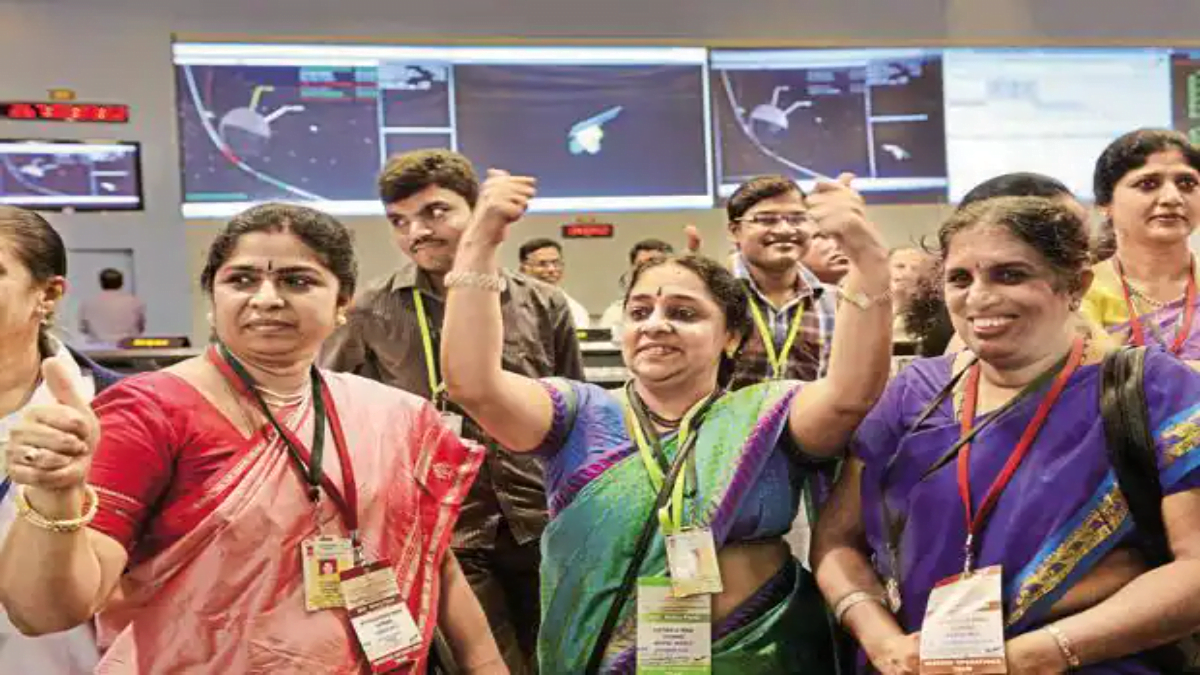




Dear Satabdi,
Your articulation is very informative and ideologically sound. I shall refer your article to my students of Women’s Studies. We teach some topics on Science and Women, often refer to 2- Vols of Feminists and Science, eds. Sumi Krishna and Gita Chadha from Stree.
One thing I like to reiterate that the cases of alcohol and (so called bad looking) jeans is very negligible, still these are referred to very often!
Thanks a lot!
Santosh Kr Pal
…are very negligible..